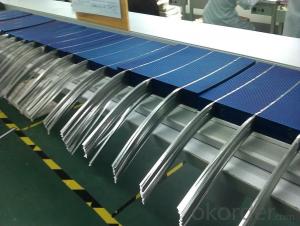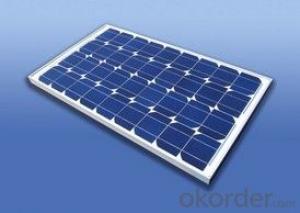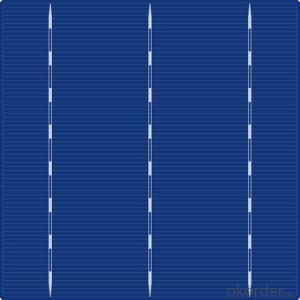Monocrytalline Silicon Solar Cells 125mm (16.50%----18.35%)
- Loading Port:
- Shanghai
- Payment Terms:
- TT OR LC
- Min Order Qty:
- 1000 watt
- Supply Capability:
- 100000000 watt/month
OKorder Service Pledge
OKorder Financial Service
You Might Also Like
Item specifice
1.Description of the Solar Cells
Monocrytalline Silicon Solar Cells 125mm (16.50%----18.35%)
We supply regular mono 125x125mm and poly 156x156mm solar cells.
Cells made in China mainland and Taiwan are both available.
Cell production capacity yearly reach 1GW.
Our cells pattern include continuous and uncontinuous busbar to meet different cells line.
2.Mechanical data and design of the Solar Cells
| Format | 125 mm × 125 mm ± 0.5 mm |
| Thickness- | 210 μm ± 40 μm |
| Front (-) | 1.6 mm bus bars (silver),blue anti-reflection coating (silicon nitride) |
| Back (+) | 2.5 mm wide soldering pads (silver) back surface field (aluminium) |
3. Temperature Coefficient of the Solar Cells
| Voc. Temp .coef.%/K | -0.35%/K |
| Isc . Temp .coef.%/K | +0.024%/K |
| Pm. Temp. coef.%/K | -0.47%/K |
4.Electrical Characteristic of the Solar Cells
Efficiency (%) | Pmpp (W) | Umpp (V) | Impp (A) | Uoc (V) | Isc (A) | FF (%) | ||
18.35 | 2.841 | 0.532 | 5.342 | 0.631 | 5.67 | 79.41% | ||
18.2 | 2.817 | 0.53 | 5.319 | 0.631 | 5.64 | 79.16% | ||
18.05 | 2.794 | 0.527 | 5.301 | 0.63 | 5.63 | 78.77% | ||
17.9 | 2.771 | 0.527 | 5.259 | 0.629 | 5.62 | 78.39% | ||
17.75 | 2.748 | 0.526 | 5.224 | 0.629 | 5.61 | 77.88% | ||
17.6 | 2.725 | 0.524 | 5.201 | 0.629 | 5.59 | 77.50% | ||
17.45 | 2.702 | 0.52 | 5.196 | 0.629 | 5.586 | 76.90% | ||
17.3 | 2.678 | 0.516 | 5.183 | 0.626 | 5.577 | 76.71% | ||
17.15 | 2.655 | 0.513 | 5.175 | 0.623 | 5.565 | 76.58% | ||
17 | 2.632 | 0.51 | 5.161 | 0.622 | 5.559 | 76.12% | ||
16.75 | 2.593 | 0.508 | 5.103 | 0.615 | 5.477 | 76.98% | ||
16.5 | 2.555 | 0.506 | 5.047 | 0.608 | 5.396 | 77.88% | ||
5.Intensity Dependence of the Solar Cells
Intensity [W/m2] | sc× [mA] | Voc× [mV] |
1000 | 1.00 | 1.000 |
900 | 0.90 | 0.989 |
500 | 0.50 | 0.963 |
300 | 0.30 | 0.939 |
200 | 0.20 | 0.920 |
6.IV Curve of the Solar Cells
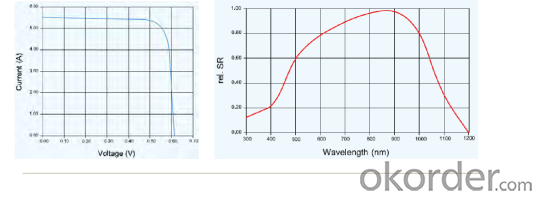
7.Applications of the Solar Cells
electric power generation
8.IMages of the Solar Cells
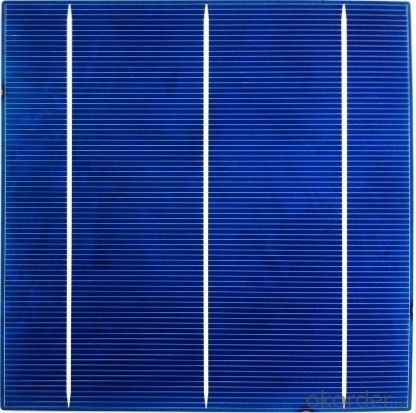

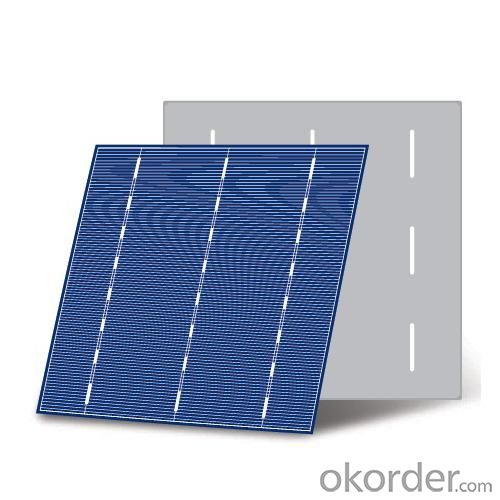
FAQ
- Q:What is the role of bypass diodes in shading situations?
- The role of bypass diodes in shading situations is to prevent the shaded cells of a solar panel from reducing the overall power output of the panel. By creating an alternative path for the current to bypass the shaded cells, bypass diodes ensure that the unshaded cells can still generate electricity efficiently. This helps to optimize the performance and reliability of the solar panel system in the presence of shading or partial shading conditions.
- Q:How much electricity can a solar cell generate?
- The amount of electricity that a solar cell can generate depends on various factors such as the size of the cell, the efficiency of the cell, the intensity of sunlight, and the duration of exposure. Generally, a solar cell can produce anywhere from a few watts to several hundred watts of electricity.
- Q:Can solar cells be used in military vehicles?
- Yes, solar cells can be used in military vehicles. They can help power various electronic systems and equipment, reducing reliance on traditional fuel sources and increasing energy efficiency. Additionally, solar cells can provide a sustainable and renewable energy solution for the military, especially in remote or off-grid operations.
- Q:Are solar cells recyclable?
- Yes, solar cells are recyclable. They contain valuable materials like silicon, glass, and metal, which can be extracted and reused. Recycling solar cells helps reduce waste and conserves resources.
- Q:What is the impact of bird nesting on solar cell performance?
- Bird nesting can have a negative impact on solar cell performance as it can lead to shading, blocking sunlight from reaching the cells and reducing their efficiency. Additionally, bird droppings can accumulate on the surface of the solar panels, further decreasing their output. Regular maintenance and cleaning are essential to minimize the impact of bird nesting on solar cell performance.
- Q:How do solar cells perform in regions with high levels of air pollution?
- Solar cells perform less efficiently in regions with high levels of air pollution. Air pollution can block sunlight and reduce the amount of solar radiation reaching the solar cells, which in turn decreases their power output. Additionally, pollutants in the air can accumulate on the surface of solar panels, forming a layer of grime that further reduces their performance. Regular cleaning and maintenance of solar panels are necessary in such regions to ensure optimal functioning.
- Q:Can solar cells be used on wearable technology?
- Yes, solar cells can be used on wearable technology. They can be integrated into various devices such as smartwatches, fitness trackers, and even clothing to provide a sustainable source of power. This allows wearables to be charged using sunlight, reducing the dependency on traditional charging methods and increasing their mobility and convenience.
- Q:Can solar cells be used in remote areas with no grid access?
- Yes, solar cells can be used in remote areas with no grid access. Solar cells convert sunlight into electricity, making them an ideal solution for remote areas where traditional power grids are not accessible. These off-grid solar systems can provide a reliable and sustainable source of electricity for various applications such as lighting, charging small devices, and powering basic appliances. Additionally, advancements in battery storage technology allow excess energy generated during the day to be stored and used during the night, ensuring continuous power supply even in remote areas without grid access.
- Q:What is a polymer solar cell and how does it work?
- Polymer solar cells are lighter than other silicon-based solar cells.
- Q:Can solar cells be used for powering outdoor signage?
- Yes, solar cells can be used for powering outdoor signage. Solar panels can convert sunlight into electricity, which can then be used to power various devices including outdoor signage. This is a sustainable and environmentally friendly option, as it reduces dependence on traditional electricity sources and helps to minimize carbon emissions.
1. Manufacturer Overview |
|
|---|---|
| Location | |
| Year Established | |
| Annual Output Value | |
| Main Markets | |
| Company Certifications | |
2. Manufacturer Certificates |
|
|---|---|
| a) Certification Name | |
| Range | |
| Reference | |
| Validity Period | |
3. Manufacturer Capability |
|
|---|---|
| a)Trade Capacity | |
| Nearest Port | |
| Export Percentage | |
| No.of Employees in Trade Department | |
| Language Spoken: | |
| b)Factory Information | |
| Factory Size: | |
| No. of Production Lines | |
| Contract Manufacturing | |
| Product Price Range | |
Send your message to us
Monocrytalline Silicon Solar Cells 125mm (16.50%----18.35%)
- Loading Port:
- Shanghai
- Payment Terms:
- TT OR LC
- Min Order Qty:
- 1000 watt
- Supply Capability:
- 100000000 watt/month
OKorder Service Pledge
OKorder Financial Service
Similar products
New products
Hot products
Hot Searches
Related keywords


